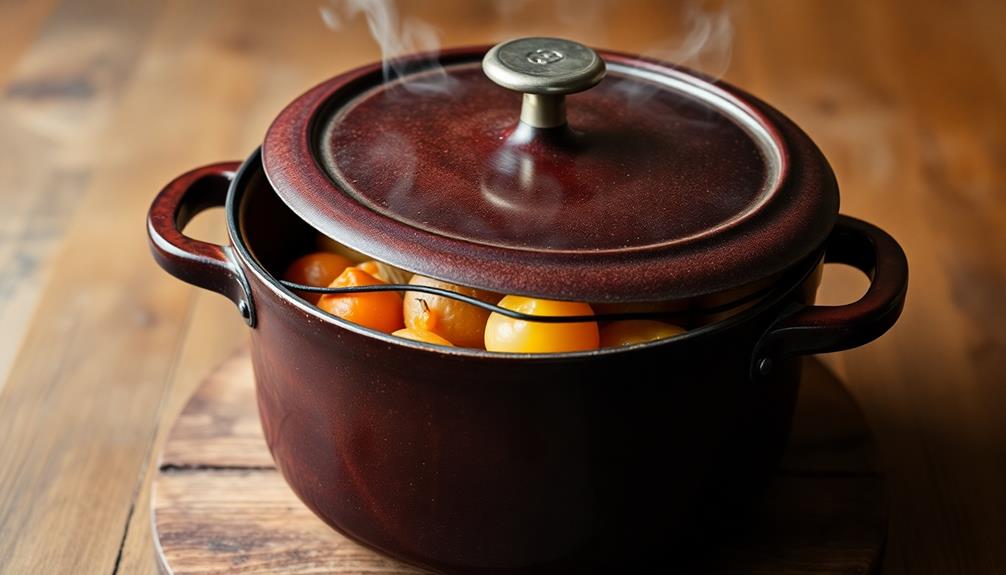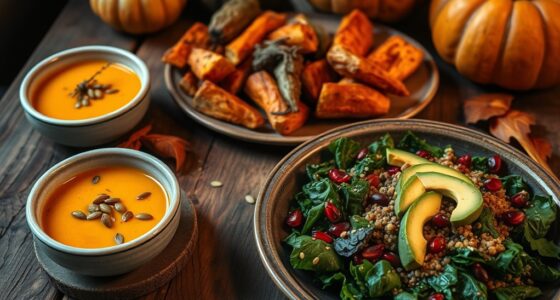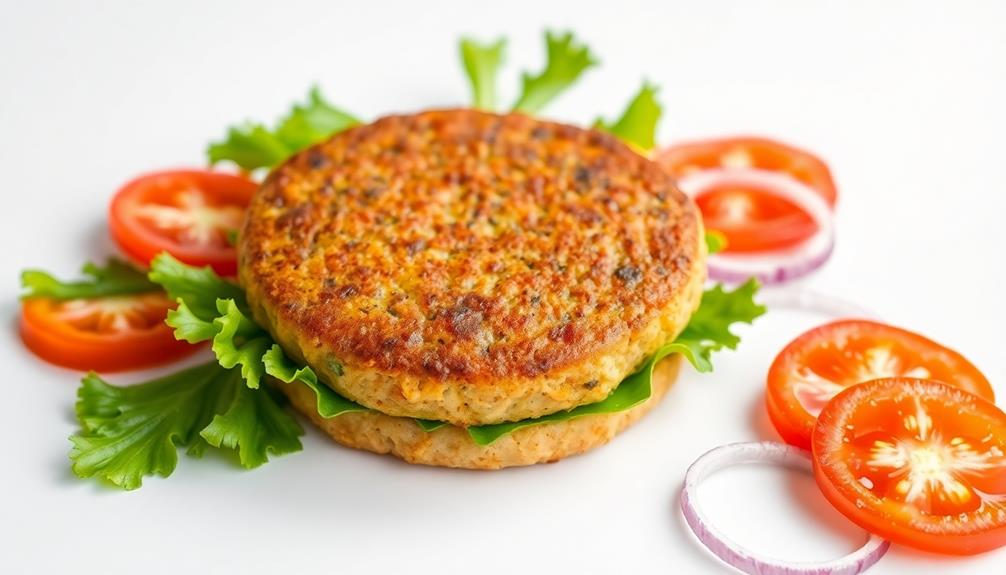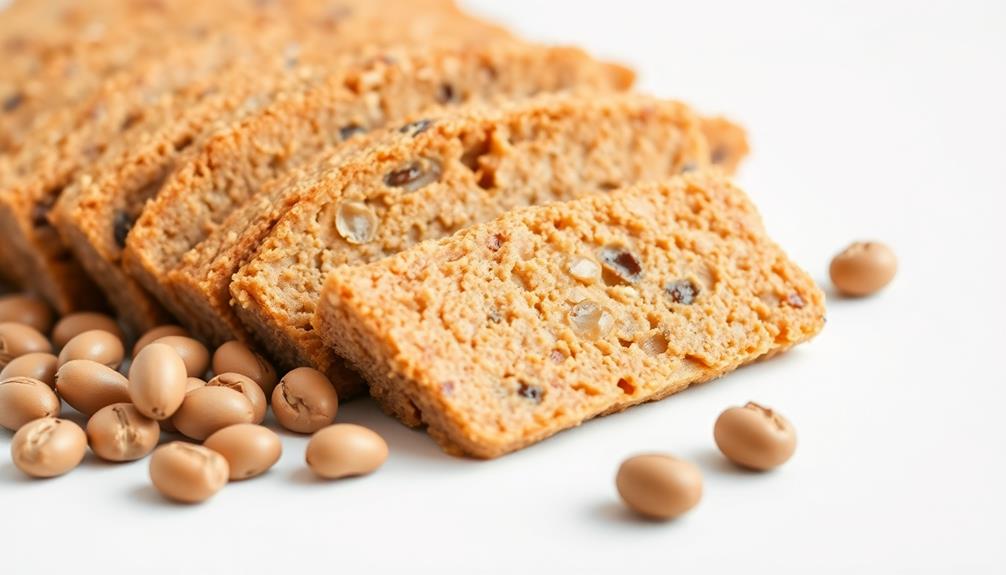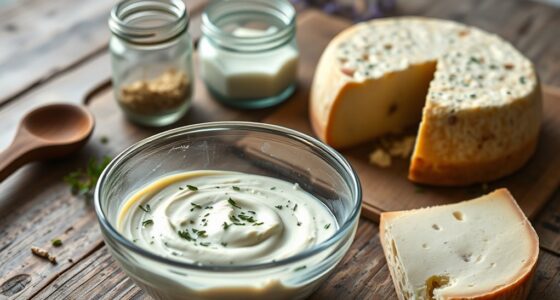Get ready to take a delicious journey into the world of nut-based vegan cheese! These dairy-free alternatives are crafted from wholesome ingredients like cashews and almonds, giving you all the flavors and textures you love, just without the cruelty. You can make your own creamy, tangy vegan cheese right at home – just soak some nuts, blend, and refrigerate. Or explore the ever-growing variety of vegan cheese products lining store shelves, from shredded to sliced. Whether you're whipping up grilled cheese sandwiches or building the perfect cheese platter, these plant-based options are sure to satisfy. And there's so much more to discover!
Key Takeaways
- Vegan cheese alternatives are often made from nuts, seeds, and plant-based ingredients, providing dairy-free options for health-conscious consumers.
- Homemade vegan cheese can be prepared by blending soaked nuts, plant-based milk, and seasonings, then refrigerating to achieve a cheese-like texture.
- Vegan cheese varieties offer a wide range of flavors, textures, and culinary applications, catering to diverse palates and dietary preferences.
- Nut-based vegan cheeses are generally packed with beneficial nutrients, lower in cholesterol, and contribute to a lower environmental impact compared to dairy cheese.
- The demand for plant-based cheese alternatives has led to increased market availability, with dedicated grocery store sections and a rise in artisanal vegan cheese brands.
History
Tracing the origins of vegan cheese alternatives, the journey begins with the rise of the plant-based movement in the 20th century. As more people became interested in living a cruelty-free lifestyle, the demand for dairy-free options grew.
Inventive cooks and scientists got to work, experimenting with nuts, seeds, and other plant-based ingredients to create cheese-like products.
Over the years, the variety of vegan cheeses has exploded. You can now find shredded, sliced, and block-style options made from cashews, almonds, coconut, and even potatoes.
The flavors have also become more diverse, ranging from classic cheddar to tangy feta. Many vegan cheeses even melt and stretch just like their dairy-based counterparts.
Today, these plant-based alternatives have become mainstream, with most grocery stores dedicating entire sections to vegan cheese products.
Whether you're looking to reduce your dairy intake or explore new culinary adventures, the world of vegan cheese is full of delicious possibilities.
Recipe
Vegan cheese alternatives can be a delicious and healthy option for those looking to reduce their dairy intake. These alternatives are made from a variety of plant-based ingredients, often providing a similar texture and flavor to traditional cheese.
In this recipe, we'll guide you through the process of creating a homemade vegan cheese that can be used in a variety of dishes, from sandwiches to pasta. This recipe is easy to follow and can be customized to suit your taste preferences.
Ingredients:
- 1 cup raw cashews, soaked in water for at least 4 hours or overnight
- 1/2 cup unsweetened almond milk
- 2 tablespoons lemon juice
- 1 teaspoon sea salt
- 1/2 teaspoon garlic powder
- 1/2 teaspoon onion powder
- 1/4 cup nutritional yeast
Instructions:
Drain and rinse the soaked cashews. Add the cashews, almond milk, lemon juice, sea salt, garlic powder, and onion powder to a high-speed blender or food processor. Blend until smooth and creamy.
Stir in the nutritional yeast and blend again until well combined. Transfer the mixture to a cheesecloth-lined strainer and let it sit for 30 minutes to 1 hour to allow excess moisture to drain.
Refrigerate the vegan cheese for at least 2 hours before using.
Tips:
- For a firmer texture, you can place the cheese in the refrigerator for longer, up to 24 hours.
- Experiment with different herbs and spices to customize the flavor to your liking.
- The vegan cheese can be used in a variety of dishes, such as grilled cheese sandwiches, mac and cheese, or as a topping for baked potatoes.
Cooking Steps
First, you'll want to soak your nuts overnight before blending them into a smooth, creamy texture.
Next, heat up the blended nuts to get them nice and warm.
Step 1. Soak Nuts Overnight Before Blending

To craft a creamy, flavorful vegan cheese, it's essential to soak your nuts overnight before blending. This simple step helps to soften the nuts, making them easier to blend into a smooth, luscious consistency.
Simply place your nuts – whether they're almonds, cashews, or a blend – into a bowl, cover them with water, and let them sit overnight. In the morning, you'll have perfectly plump and hydrated nuts, ready to be transformed into your dream vegan cheese.
The soaking process does more than just soften the nuts. It also helps to unlock their natural nutrients, making them even more nourishing and delicious.
Plus, it's an easy way to get a head start on your recipe, so you can whip up your vegan cheese in a flash when you're ready to cook.
Step 2. Blend Soaked Nuts Until Smooth
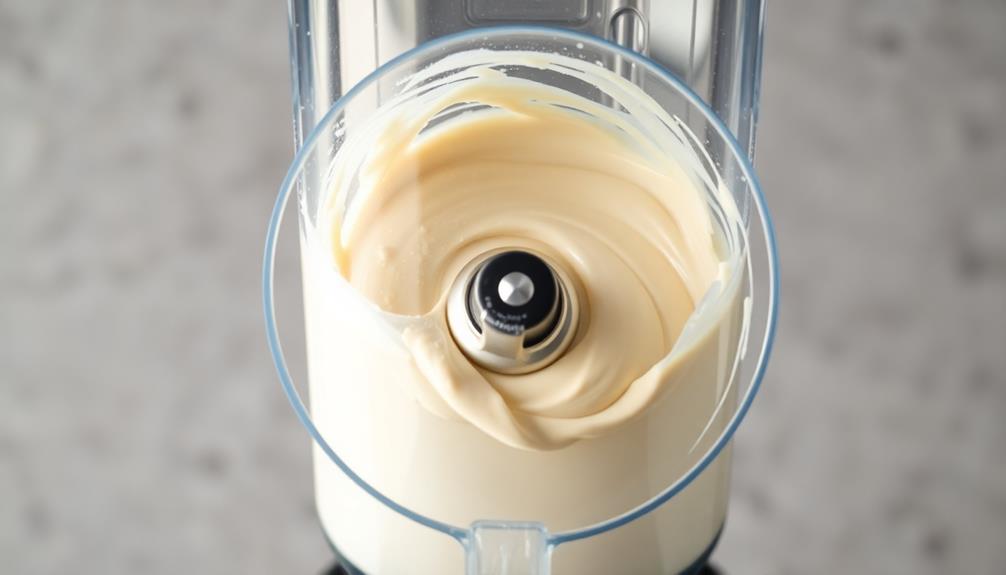
After you've soaked your nuts overnight, it's time to blend them into a smooth, creamy base for your vegan cheese. This is where the magic happens!
Grab your high-speed blender and add the soaked nuts. Start blending on low, then gradually increase the speed until the mixture becomes silky smooth. You'll know it's ready when there are no more crunchy bits.
Don't be afraid to blend for a few extra minutes to get that perfect, luxurious texture. Once it's blended, you can add in any seasonings or flavorings you like, such as garlic, herbs, or spices.
Give it a good stir to incorporate everything evenly. Now you've got a versatile, nut-based cheese that's ready to be transformed into all kinds of delicious vegan recipes.
Get creative and have fun experimenting with different flavors and textures! Your taste buds are in for a real treat.
Step 3. Heat the Blended Nuts
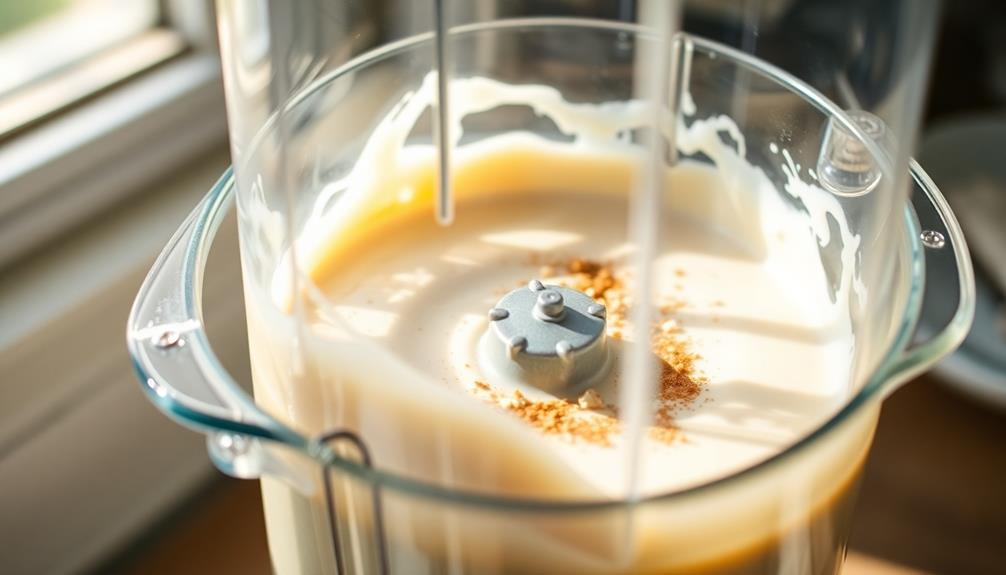
With your nut-based cheese base now blended to perfection, it's time to heat things up.
Grab a saucepan and gently pour in your creamy nut mixture. Turn the burner to medium-low heat, and let the magic begin. As the pan warms, you'll start to smell the nutty aroma wafting through the air – it's heavenly!
Slowly, the nut cheese will begin to transform, becoming thicker and creamier with each passing minute. Keep a close eye on it, stirring occasionally to prevent any sticking or burning. You want to heat it just until it's warm and pliable, but not boiling hot.
Once it reaches the perfect consistency, remove the pan from the heat. Your vegan cheese alternative is now ready to be shaped, seasoned, and used in all sorts of delicious recipes.
Get creative and have fun with it!
Step 4. Stir in Desired Seasonings
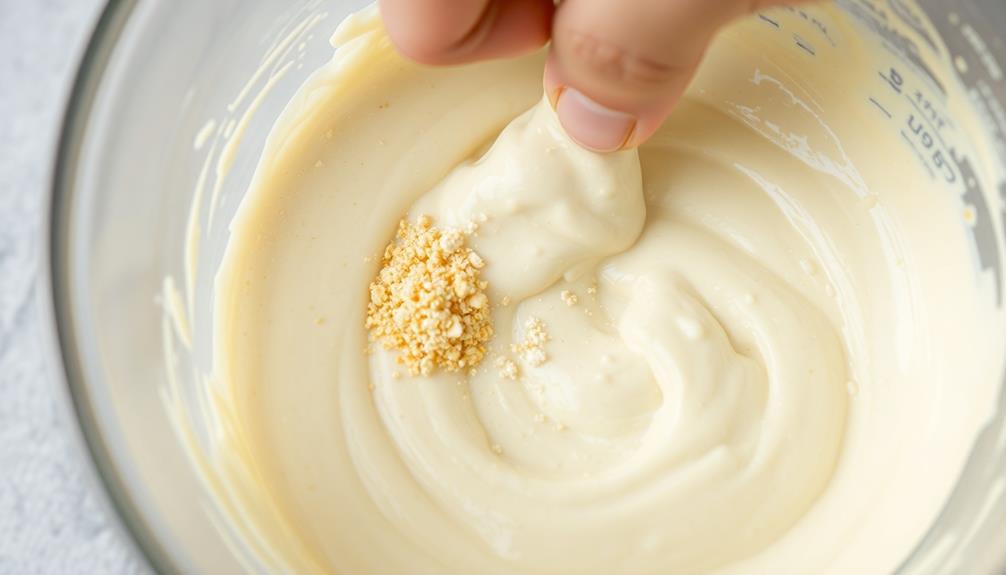
Once the nut cheese base has been warmed through, it's time to add in your desired seasonings. This is where you can get creative and really make the cheese your own!
Start by adding a pinch or two of your favorite herbs, like fresh thyme, rosemary, or basil. These will give your cheese a lovely aromatic boost. Don't be afraid to experiment – try a dash of garlic powder or onion powder for a savory kick, or a sprinkle of smoked paprika for a touch of smoky flavor.
Next, consider adding a bit of salt and pepper to taste. This will help balance out the flavors and really make the cheese shine. Stir everything together gently until the seasonings are evenly distributed throughout the cheese.
Now, give it a taste and adjust the seasonings as needed. You want the flavors to be bold and harmonious, so don't be afraid to add a little more of what you love. With the right blend of spices, your nut-based cheese will be absolutely delicious!
Step 5. Pour Into Mold
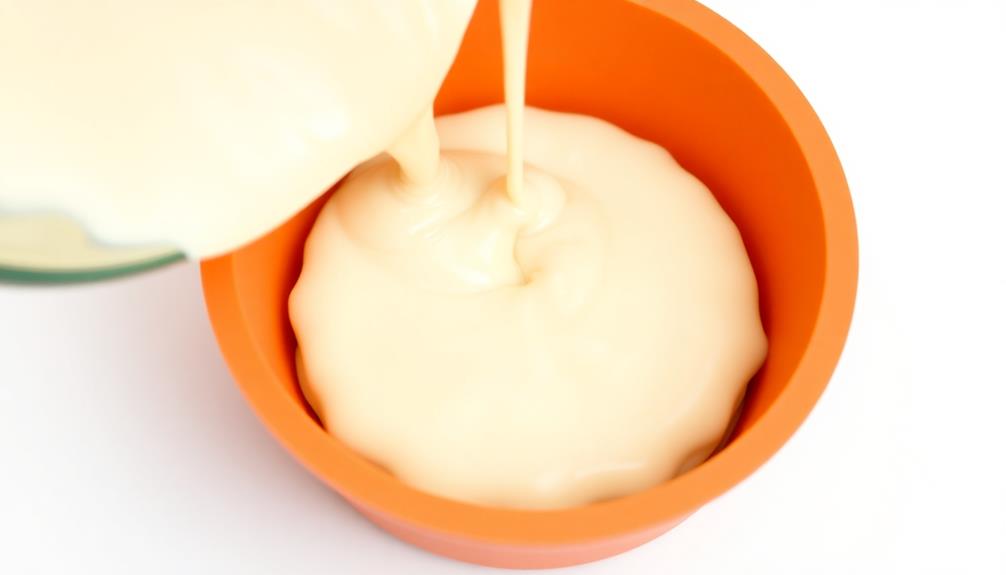
Now that you've seasoned your nut cheese to perfection, it's time to pour it into a mold.
Whether you're using a simple container or a fancy cheese mold, the process is the same. Grab your prepared cashew or almond cheese mixture and carefully spoon it into your chosen mold.
Use a spatula to smooth the top and ensure it's evenly distributed. Don't be afraid to pack it in tightly – you want a nice, firm block of cheese.
Once it's all in, gently tap the mold on the counter to help settle the cheese and remove any air pockets.
Finally, cover the top with a piece of parchment paper or plastic wrap to prevent a skin from forming as it chills.
Pop it in the fridge and let the magic happen! In a few hours, or even overnight, your homemade vegan cheese will be firm and ready to slice, dice, or crumble.
Final Thoughts
As a health-conscious consumer, the emergence of vegan cheese alternatives presents a promising landscape for those seeking dairy-free options. These innovative products, crafted from wholesome ingredients like nuts, offer a delightful way to enjoy the familiar flavors and textures of traditional cheese without the animal-based components. Furthermore, the versatility of vegan cheese alternatives makes them a valuable addition to any kitchen. From melting into deliciously gooey toppings for pizza and nachos to being spread on crackers or used in salads, this versatile dairy alternative can be used in a wide variety of recipes. Its rich and creamy taste makes it a great option for those looking to cut down on dairy without sacrificing flavor.
Whether you're whipping up a savory grilled cheese sandwich, topping a fresh salad, or indulging in a decadent cheese platter, the versatility of vegan cheeses allows you to reimagine your favorite recipes.
With a wide array of flavors, from tangy and sharp to creamy and mild, there's a perfect vegan cheese to suit every palate. And the best part? These dairy-free delights are often packed with beneficial nutrients, making them a nutritious choice for you and your family.
As you explore the expanding world of vegan cheese alternatives, embrace the opportunity to create new culinary adventures and discover the joys of dairy-free indulgence.
Frequently Asked Questions
How Long Does Vegan Cheese Last in the Refrigerator?
Unopened, vegan cheese can typically last 2-3 weeks in the refrigerator. Once opened, it'll generally stay fresh for 5-7 days. To maximize its shelf life, store it in an airtight container and keep it chilled.
Is Vegan Cheese Suitable for People With Nut Allergies?
Unfortunately, most vegan cheeses are nut-based, so they're not suitable for people with nut allergies. You'll need to carefully read the labels and avoid any products containing nuts or tree nuts to ensure your safety.
Can Vegan Cheese Be Used in Baking and Cooking?
You can definitely use vegan cheese in baking and cooking. It melts and behaves similarly to dairy-based cheese, making it a great substitute in many recipes. Just be mindful of the specific ingredients if you have dietary restrictions.
What Is the Nutritional Profile of Vegan Cheese?
The nutritional profile of vegan cheese varies, but it's typically lower in protein and calcium than dairy cheese. However, it can be a good source of healthy fats from nuts or coconut. Check the label to find one that fits your dietary needs.
How Does the Price of Vegan Cheese Compare to Traditional Cheese?
Vegan cheese is typically more expensive than traditional dairy-based cheese. The specialized ingredients and production process drive up the cost, making it less affordable for some consumers. However, the price difference may be worth it for those seeking plant-based alternatives.

